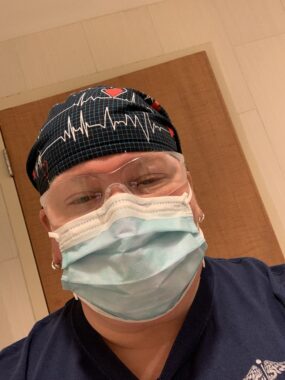Answering the call: What emergency responders do, Part 2
What patients and caregivers should know when going to the ER

Second in a series. Read part one.
According to the Online Etymology Dictionary, “emergency” is derived from the Latin word “emergere,” which means to come forth, to rise up and out. That is what our brave emergency responders do. They rise up, emerge, and help patients and caregivers through situations they cannot handle on their own.
Last week, fire service paramedic Michelle Roche explained what to expect when first responders arrive at a scene.
Now we hear from Linda Wrigley, 50, a registered nurse, whom I interviewed via email. I asked Linda to share her experience as an emergency room (ER) nurse and offer advice for when patients and caregivers arrive at the emergency department.

Linda Wrigley works hard in the emergency department during the pandemic, in May 2020. (Courtesy of Linda Wrigley)
Called to help others
Linda grew up in a house of service. Her mom, Eileen Wrigley, was a volunteer EMT and her father, Frank Wrigley, a volunteer firefighter. It makes sense that Linda would follow in their footsteps.
After completing an EMT course during her sophomore year of college, Linda volunteered as an EMT in Maple Shade, New Jersey, for 11 years.
Being an EMT is not part of the process to becoming a nurse, but the experience helped spark her desire to pursue nursing.
Linda is proud of being a registered nurse for 25 years. She refers to it not as a job but as a calling, which she answers with compassion, empathy, and nurturing. Since January 2015, she has helped many people as an ED nurse at Ocean University Medical Center in New Jersey.
Bringing important medical information, kindness to the ER
To help better meet patients’ needs, Linda advises caregivers to have available the following information for medical staff: a current list of all medications, including oxygen, inhalers, dosages, and frequency; a list of allergies and reactions; code status and medical power of attorney paperwork; medical history, including surgeries; and physicians managing their care. If the patient has a trach, the size and type are imperative to their care.
A point person who will communicate with hospital staff is also important. “At times, we field phone calls from many different family members, and we are constantly retelling the same information,” Linda explained. “A point person will allow communication with one family member who can then disseminate to the rest of the family.”
Linda sympathizes that having a loved one in the hospital is stressful, but it’s appreciated when caregivers are helpful without being overbearing. Nurses can be responsible for up to seven patients. Lingering at the nursing station and asking repeated questions slows down care for all of them.
Linda helps ease anxiety by explaining to family, “The less of us at the bedside, the less critical your loved one is. We will update you as soon as we know something more, and a lot of times, no news is good news.”
In addition to patience, Linda emphasizes the need for kindness.
She points out that we live in a difficult time in medical history. Patients are sicker than ever and being discharged earlier. Families feel unprepared to handle these situations, and medical teams, especially nurses, feel stressed and pressured.
I can sympathize with how upsetting it must be when patients or caregivers take their frustrations out on nurses.
Linda wants us to remember that kindness matters!
“None of us became nurses to cause more pain and frustration, so kindness goes a long way.” She backs this with wise words her mom used to say: “You get more bees with honey than you do with vinegar!”
Emergency room process
Linda explains that your arrival at the ER by ambulance or walk-in begins with triage. The first nurse you meet does the initial intake, which consists of asking what brought you to the ER and requesting the important medical information Linda previously advised caregivers to have on hand.
Next, you are assigned to a room based on acuity (how sick you are). The sicker you are, the lower your number. For example:
- Stroke, unconscious, requiring CPR
- Chest pain, shortness of breath
- Abdominal pain, fall
- Sprained ankle
- Medication refill, suture removal
Once settled, the patient will meet with the primary nurse, who is able to start an IV, do labs, and provide medications such as Tylenol, anti-nausea meds, breathing treatments, and IV fluids. Linda explained that each facility has its own protocol of what nurses can initiate.
ER doctors will review your treatment history and reach out to specialists regarding continuous infusion specialty medications.
When the ER doctor, physician’s assistant, or nurse practitioner sees the patient, they will order additional diagnostic tests, medications, and labs, the results of which can take up to 90 minutes.
“This is where being patient is helpful to the nurse and where the less you see of us at the bedside the more OK you are,” Linda reiterated.
Nursing has been a rewarding experience for Linda. Educating her patients and advocating for them is most important to her, and she concluded with confidence, “I will always attempt to do this with compassion.”
Note: Pulmonary Hypertension News is strictly a news and information website about the disease. It does not provide medical advice, diagnosis, or treatment. This content is not intended to be a substitute for professional medical advice, diagnosis, or treatment. Always seek the advice of your physician or other qualified health provider with any questions you may have regarding a medical condition. Never disregard professional medical advice or delay in seeking it because of something you have read on this website. The opinions expressed in this column are not those of Pulmonary Hypertension News or its parent company, Bionews, and are intended to spark discussion about issues pertaining to pulmonary hypertension.









Leave a comment
Fill in the required fields to post. Your email address will not be published.